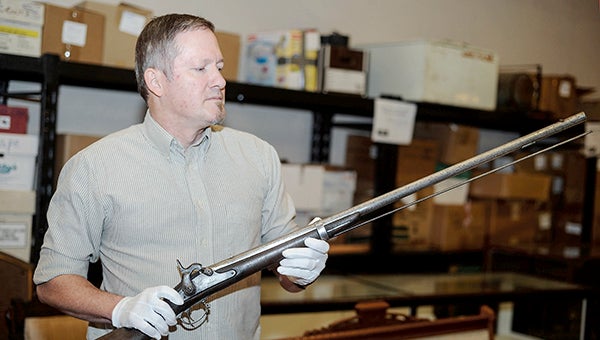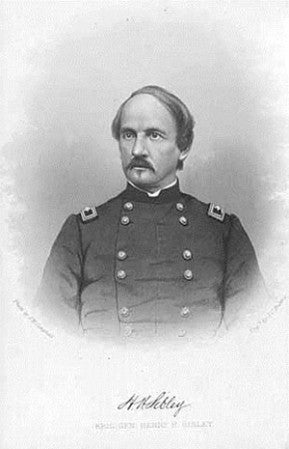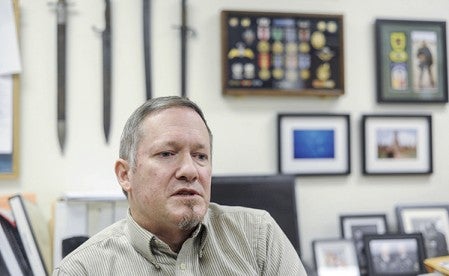Words of the law: Local man authors book on Dakota war trials

John Haymond, executive director of the Mower County Historical Society, holds a musket of the kind that would have been used during the U.S.-Dakota War of 1862. Haymond has authored a book from the military law aspect of the trials that grew from the end of the conflict. Eric Johnson/photodesk@austindailyherald.com
John Haymond didn’t take your typical route to writing a book but here he is — the author of a new book set to come out next year on the U.S.-Dakota Indian War of 1862.
“I’m tremendously excited,” Haymond, executive director for the Mower County Historical Society, said from his office, surrounded by stacks of paper and historical memorabilia.
The working title of the book, to be published by McFarland and Company, Inc., is “Dakota War Trials of 1862,” though that’s likely to change, even if slightly by the time the book comes out.
It marks the end of a period in Haymond’s life that saw him pursue a subject that not only has been written about by plenty of authors and historians but a subject he really wasn’t that interested with in the first place.
“I didn’t have really any interest,” he said.
But it was one set of words from Henry Sibly who presided over the Dakota War Trials that that ultimately led Haymond to write the book.

Henry Sibley. Photo courtesy of the Minnesota Historic Society
Background
But first, some context.
Haymond made his first run at college right out of high school, but admits he was a terrible student so he opted for the military, joining the U.S. Army with an intent to serve out a four-year stint.
That was a four-year stint that turned into a 21-year military career.
“I liked it a whole lot more than I thought,” Haymond said.
When he retired, he decided to give college a try once again in an attempt to pursue a life-long goal of being an English professor. Heading to the University of Minnesota-Duluth, Haymond made it two semesters before his advisor set about advising him down a different path.
“He said, ‘when it comes to English you’re brilliant, but you’re only excited when you talk about history,’” Haymond said.
Ultimately he earned a BA in history before he and his wife, Elena, who is currently teaching at Riverland Community College, decided they would both try for their master’s degrees. That road took them across the pond to the University of Edinburgh where he received his masters of science in history. His wife received a master’s of science in Human Osteo Archaeology.
“She’s got the cool job,” Haymond joked.
Drawn in
Haymond started writing the book in 2011, dedicating four years of writing and research to authoring the book. But he was drawn to the subject years before during his last semester at UMD.
Haymond needed to write a paper, roughly about 40 pages and so he thought he would write about something he thought he knew plenty about. The U.S.-Dakota War of 1862. Something he readily admits to being wrong about.
“I thought I knew everything,” Haymond said.
When he got to the Minnesota Historical Society he realized how wrong he was. He eventually read a letter from Sibley to Bishop Henry Benjamin Whipple that gave Haymond insight into how Sibley ran the commission of the Dakota War Trials.
“Certain cases were found not guilty,” Haymond explained. “Sibley didn’t agree and sent them back to the court and they were found guilty.”
Haymond went on to explain that in a military trial there are three options: Allow the sentence, reduce the sentence or throw it out. Prosecutors can’t do anything to worsen the sentence.
“It was such an egregious error,” Haymond said. “Sibley should have been brought up on charges.”

John Haymond talks about the background to the content in his book. Eric Johnson/photodesk@austindailyherald.com
Haymond took that and ran, approaching the trials through the military law aspect. Even though the subject has been thoroughly written about, Haymond believes that aspect has never been looked at. It’s also more than simply writing again about a subject.
“The first day I realized, it’s not always a case of finding something people didn’t know about,” he said. “It’s a case of finding something people knew about and presenting it in a different perspective.”
It was a light-bulb moment for Haymond who dove right in.
“It was shocking he would have said that,” Haymond said, thinking back to Sibley’s correspondence. “It’s such a damning self-indictment.”
From there the challenges began in earnst. It’s one thing to say Sibley did this, but it’s something entirely different to prove it. Academia requires proof and nothing short.
Haymond began digging through several trial transcripts, all hand written in sometimes difficult-to-read handwriting and often times including words that were struck out and other words that were added.
It was here though where Haymond found his proof. On several of the transcripts Haymond found instances where the sentence was written either as not guilty or guilty of a lesser charge, only to be crossed out and changed to guilty and sentenced to death.
Haymond found one where the accused received a five-year sentence only to have it reversed and the man sentenced to death.
“Sibley sent back at least 20 cases that I could find,” Haymond said.
In total, 303 adult males from the Dakota were sentenced to death, but an overwhelming majority had there sentences reversed. Back in those days a sentence of death had to be confirmed by the President of the United States, who at that time was Abraham Lincoln.
Lincoln only confirmed 39 of the sentences which ultimately led to 38 after one man was cleared at the last minute.
Haymond originally thought he was done with the book three years ago.
“I thought I had the book finished in 2012,” he said. “In hindsight, it was nowhere close.”
His time working on the book also forced Haymond to come to terms with what he thought he knew about the war and about Sibley himself.
“I originally felt, Sibley was unfairly criticized,” he said. “My conclusions are true in some cases, but many things he did I think he hasn’t been criticized enough.”
Friends of Haymond have warned him of backlash given the emotional package still attached to the war and trials.
A professor friend of his told him as much after reading an early draft.
“He said, ‘you need to be prepared if this gets published because this will piss a lot of people off.’”
Haymond laughed when he recalled being taken back and worried about it, but his friend told him to not be.
“That means they are reading it,” Haymond remembered him saying.
Haymond recalled also worrying about what he wrote when he got the news he was being published. According to McFarland guidelines, a response of 4 to 6 weeks was typical. Five days later he got his response which brought a sense of reality to the book.
“It took my breath away,” Haymond said. “I went back and very carefully focused on those parts that were contradictory to make sure the voice was professional, scholarly and supportive.”
Haymond said he has a very specific hope for the book.
“I hope it clears away some of the confusion,” Haymond said. “To get people to think of other factors.”
From a professional standpoint, Haymond believes the timing of the book is also good for the historical society.
“From my perspective, I’m happy to have the book coming out now,” he said. “The Mower County Historical Society is developing into a professional organization. I want this to be a place where real research happens.”

